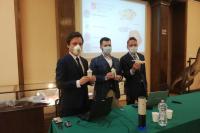Scientists from the Warsaw University of Technology supporting paleontologists in testing their discovery

In the photo, left to right: Andrzej Wolniewicz, Ph.D., Maksymilian Sienkiewicz, M.Sc., Eng., and Tomasz Sulej, Ph.D., D.Sc., during the presentation
The Polish researchers and their Danish colleague, Professor Niels Bonde, have described the 215-million year-old remains of the oldest ever discovered mammaliaform, found in Greenland. Although the fossils consist only of a jawbone with two teeth, the molar is the first double-rooted tooth ever found. Together with the scientists of the Faculty of Power and Aeronautical Engineering, Warsaw University of Technology, the paleontologists have tested the resilience of this type of teeth.
The researchers have proved that mammaliaforms, which evolved to be omnivorous, had the tooth crown that was expanding laterally, which involved high mechanical lateral stresses. With such a crown, double-rooted teeth were more resistant than single-rooted teeth. The description of the newly discovered species, named Kalaallitkigun jenkinsi, has only recently been published in PNAS, a prestigious American scientific journal.
Expedition
The idea to organize the expedition to Greenland was put forward by Tomasz Sulej, Ph.D., who was inspired by the stories told by professor Bonde, one of the participants in the American mission organized in the 1990s to analyze the late Triassic deposits from 205 million years ago. The American team found there skeletons of dinosaurs, turtle shells and remains of mammaliaforms. A discovery which caused much stir in the scientific circles at that time was a jawbone of an herbivorous mammaliaform from the haramiyidan clade.
The project of Polish expedition received support from the National Science Centre (NCN) and in 2014 the team departed for Greenland, with the following persons aboard: Tomasz Sulej, Ph.D., and Błażej Błażejewski, Ph.D., from the Institute of Paleobiology at the Polish Academy of Sciences, Mateusz Tałanda, Ph.D., from the University of Warsaw, Grzegorz Niedźwiedzki, Ph.D., from the Uppsala University, Andrzej Wolniewicz, Oxford student, and professor Niels Bonde from the Natural History Museum of Denmark in Copenhagen.
The researchers focused on combing through the rocks that were older than the ones where the remains described by the Americans had been found. The fragment of a jawbone was found by Grzegorz Niedźwiedzki, Ph.D.
Tests
Scanning the jawbone with the microtomograph Nanofun gave the picture of a molar with two roots and a very particular crown. Niedźwiedzki, Ph.D., noted a very wide cavity between the rows of cusps and he immediately thought of the teeth found in a slightly younger herbivorous mammaliaform from Greenland, Haramiyavia. His suspicions proved to be correct and a more detailed analysis demonstrated that Kalaallitkigun is the intermediate form between the already described insectivorous mammaliaforms and the herbivorous mammaliaform from Greenland. It is a new species, the first intermediate link between the small insectivorous mammaliaforms and their slightly bigger, omnivorous successors. The teeth in those two groups differ largely and the newly found fossil from Greenland explains the pattern of their dental morphological evolution.
Why single-rooted teeth evolved into double-rooted teeth?
Sulej, Ph.D., asked the scientists from the Warsaw University of Technology to create 3D models in order to verify the impact of the double-rooted structure on resilience during chewing, in comparison to the single-rooted structure. Grzegorz Krzesiński, Ph.D., D.Sc., Eng., from the Faculty of Power and Aeronautical Engineering, agreed to conduct the tests, and invited his student, Maksymilian Sienkiewicz, and Piotr Gutowski, Ph.D., from the Warsaw Medical University, to join him in the project. The tests were conducted on the models obtained with the use of tomography imaging. Two teeth structures were analyzed – one with double roots and one with a single root. The tests involved typical stresses that occur during chewing.
It turned out that the stress at the basis of a double-rooted tooth is significantly lower. Therefore, the change in the root structure was important in terms of adaptation and was one of the innovations which determined the evolutionary success of our ancestors.
Mammaliaforms
It has been known for some time now that mammals evolved from cynodonts in the Late Triassic period. Cynodonts were a widely distributed group of rather small mammal-like reptiles. The first mammals were similar to today’s shrews in size and in how they lived. Until recently it was believed that their distinctive feature were three auditory ossicles in the ear. Today, we know of so many intermediate forms that this definition became obsolete. However, it draws attention to some very important features that changed when organisms evolved from cynodonts, through mammaliaforms, to mammals. Those changes included a reduced body size, a simplified jawbone, which turned into one-bone, more durable structure, as well as a more complex structure of molars. Molars started to feature many cusps that formed two rows. The previous single oval root started to expand, then its narrowing occurred, and finally it split into two independent roots. This process took place simultaneously in various groups of cynodonts but only in the case of mammaliaforms it led to a high diversification of eating patterns, and as a result, a diversification of molar crowns. Therefore, already at the end of the Triassic and the beginning of the Jurassic period there lived insectivorous and herbivorous mammaliaforms from the haramiyidan clade. The latest discovery from Greenland is precisely the oldest representative of this group, with molars in an intermediate form between those typical of the haramiyidan clade and those found in the insectivorous organisms.
Yesterday, the research results were presented by the scientists during the press conference at the Polish Academy of Sciences.
The paper has been published in PNAS and is available on the PNAS website.







